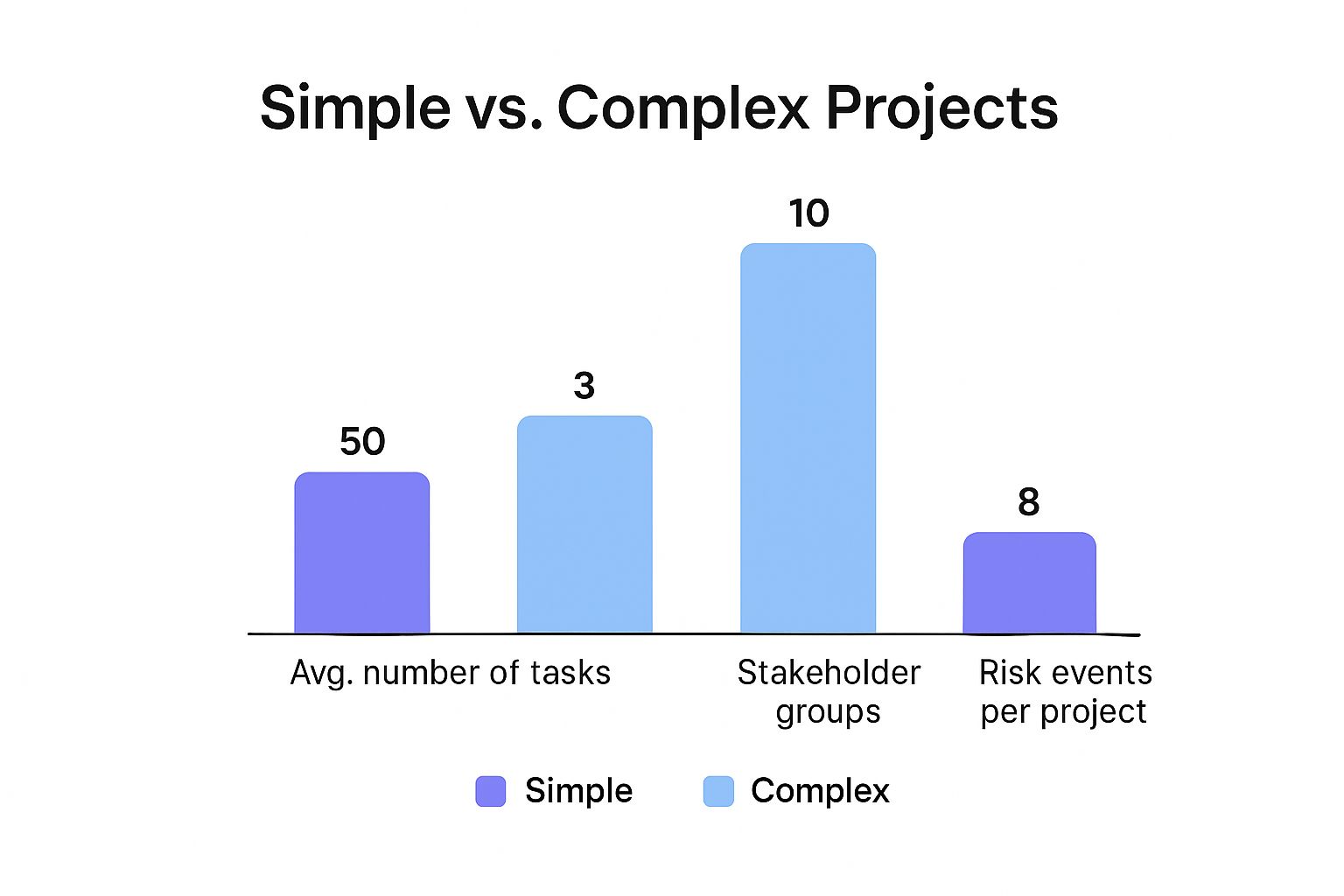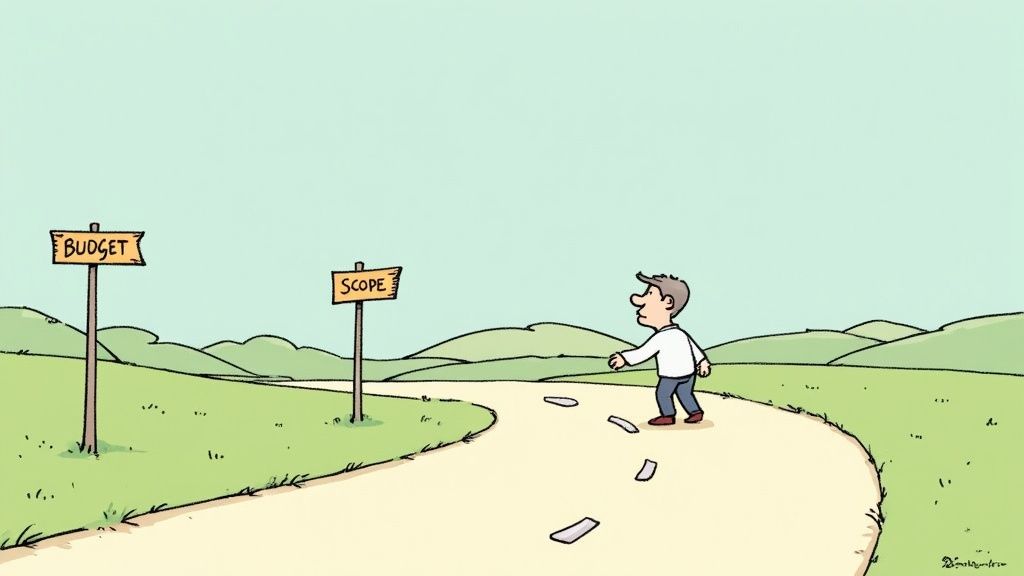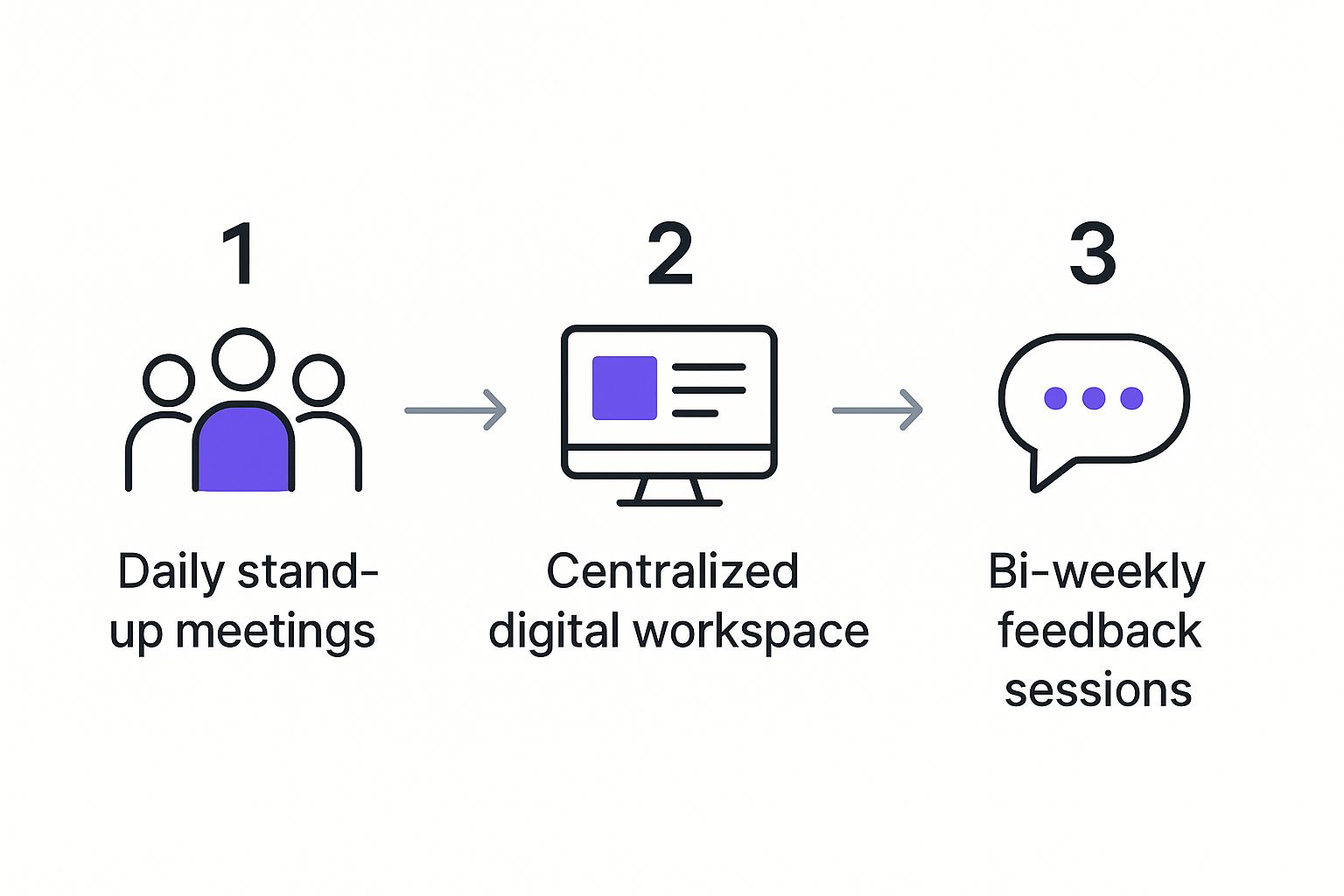When a project starts getting tangled, the temptation is to track more tasks. But that's not the real work. The real work is orchestrating people, untangling dependencies, and staring down risk. It’s about creating a shared understanding from the very beginning, rallying your team around the same goals, and building a system that can bend without breaking when things get messy.
The Real Costs of Project Complexity
Before we jump into solutions, let’s be direct about the problem. A complex project isn’t just a long to-do list. It’s a constant battle against a web of dependencies, goalposts that keep moving, and a resource drain that can sink even the most solid plans.
We sit with leaders who are pulling their hair out over the same issues. They have brilliant, dedicated teams, but they’re stuck. They are drowning in meetings, decisions get bottlenecked, and nothing seems to move forward, even though everyone is flat-out busy. That's the operational fog that descends when complexity isn't managed head-on.
The fallout isn't just a bit of frustration; it’s a direct hit to the bottom line. A huge part of that comes from squandering resources, which is why mastering optimizing resource allocation is a game-changer.
The tangible and intangible price tag.
When we talk about costs, it’s easy to point to blown budgets and missed deadlines. Those are the obvious culprits. But the real damage from mismanaged complexity is quieter, and it eats away at the very core of your organisation.
Here’s what we see time and time again:
- Wasted Investment. Money and effort are poured into work that has no clear direction or does not connect to the big-picture strategy.
- Plummeting Morale. Your best people get burnt out and disengaged from the constant firefighting and the feeling of running in place.
- Decision Paralysis. Without a single, trusted source of truth, leaders cannot make sharp, confident calls when it counts.
- Reputational Harm. When you consistently miss the mark, you damage trust—with customers, with partners, and even with your own people.
These are not isolated incidents. Data from the UK shows that around 37% of projects fail simply because of unclear goals—a classic symptom of unmanaged complexity. To put a number on it, an average of 11.4% of every pound invested in projects is wasted due to poor performance. It’s a stark picture.
Visualising the challenge.
The jump from a simple project to a complex one isn’t a straight line. It is an explosion of moving parts. This is what it looks like when you compare the key metrics side-by-side.

This just shows how the management overhead balloons, demanding a far more sophisticated approach than a simple task list can ever offer.
The core problem is rarely a lack of effort. It’s a lack of a shared system for seeing, understanding, and acting on complexity together. Without this, even the best teams are set up to fail.
We've seen that the best way to get a grip on the chaos is to diagnose what’s really causing the pain. Is it a lack of clarity around who owns what? An overly bureaucratic approval process? Or is the tech you’re using failing to give your team the collective intelligence they need to move forward?
Getting to the bottom of these specific blockers is the only way to start untangling the knots. From there, you can build a more resilient, capable, and frankly, more sustainable way of working. It’s not about adding more rigid processes. It’s about giving your people the clarity they need to succeed.
Align Your People Before Your Processes

When a project gets complicated, what is the first instinct? For many leaders, it’s to grab a new tool or framework. They rush to roll out new software or a rigid methodology, hoping it will somehow force order onto the chaos.
This approach almost always backfires. It skips the most crucial part of the equation.
Success in managing complex projects does not start with processes; it starts with people. Technology and frameworks are just amplifiers. For a well-aligned team, they amplify effectiveness. For a disconnected one, they just amplify the dysfunction. The bedrock of any ambitious project must be a team that’s genuinely aligned and committed.
Our whole philosophy is built on this people-first principle. We cut through the operational fog by making sure every single person involved knows their role, their responsibilities, and exactly how their work slots into the bigger picture. This is not about one kickoff meeting. It is about building a living, breathing system of shared understanding.
Cultivate genuine stakeholder buy-in.
Getting stakeholders to nod along in a meeting is easy. Getting their deep, active commitment? That’s a different beast entirely. That surface-level agreement vanishes at the first sign of trouble, leaving you and your team completely exposed.
Real buy-in is earned through transparency and shared ownership. It means bringing stakeholders into the planning process from the very beginning, not just showing them a finished plan and asking for a rubber stamp. We run workshops where leaders and team members work together to define what success looks like, map out dependencies, and call out risks before they become problems.
This hands-on approach delivers some serious benefits:
- It builds collective intelligence. When you pool diverse perspectives, you spot the blind spots you would have missed on your own and create far more resilient plans.
- It fosters accountability. People who help build the plan feel a personal stake in making sure it succeeds.
- It clarifies expectations. The process forces honest conversations about priorities, resources, and trade-offs, heading off misunderstandings later on.
To get your people aligned, especially when teams are pulled from different departments, it is worth exploring proven strategies for managing cross-functional teams to really get collaboration firing on all cylinders.
We believe that a project plan is not a document to be defended. It is a shared hypothesis to be tested and adapted by an aligned team. This mindset shift is fundamental to navigating complexity.
Define roles with uncompromising clarity.
Ambiguity is the perfect fuel for conflict and delay. When roles are fuzzy, tasks get dropped, decisions grind to a halt, and people waste precious energy on office politics instead of getting work done. When you are managing complex projects, defining who does what is not just bureaucratic box-ticking. It is a strategic imperative.
We use simple but powerful tools like a RACI matrix (Responsible, Accountable, Consulted, Informed), but we do not just fill it out and file it away. We treat it as a conversation starter. The real value is in the discussions that happen while you create it, forcing the team to tackle potential overlaps and gaps head-on.
This clarity goes beyond tasks. It’s about decision rights. Who can sign off on a budget change? Who has the final say on a design feature? Who just needs to be kept in the loop? Answering these questions upfront gets rid of major bottlenecks down the road. It empowers people to act confidently within their roles, which massively speeds things up.
Foster a culture of psychological safety.
Often, the most valuable insights on a complex project come from the people closest to the work. They are the first to see a flawed assumption, a new risk popping up, or a smarter way to do something. But will they speak up?
That completely depends on the level of psychological safety in the team. Study after study shows that teams where people feel safe to take risks—to ask a 'stupid' question, admit a mistake, or challenge the status quo—massively outperform those where they do not.
Building this culture is an active, ongoing process. It means leaders must model vulnerability by admitting their own mistakes. It means reframing ‘failures’ as learning opportunities. And it means creating structured moments for honest feedback, like regular retrospectives where the goal is to improve the system, not point fingers.
When people feel safe, they bring their full intelligence to the table. That’s how a team’s collective IQ becomes greater than the sum of its parts—creating a resilient force that can adapt and thrive no matter how complex things get.
Build an Adaptive Governance Framework
When a project gets complicated, the knee-jerk reaction for many organisations is to wrap it in more red tape. More meetings, more sign-off stages, more rigid rules. We've seen it time and time again, and it almost never works. Instead of creating clarity, it just builds bottlenecks and grinds everything to a halt.
Effective governance on a complex project isn’t about control. It’s about enablement. What you need is a lightweight, adaptive framework that empowers your team, clears the path for decisions, and helps maintain momentum. It’s about providing just enough structure to keep things on track, without killing the flexibility you need to deal with the unexpected.
We have seen first-hand how a chaotic, meeting-heavy structure can completely paralyse a project. The goal here is to design a system that fits your project's unique DNA, not to force a one-size-fits-all model onto your team.
Design clear decision pathways.
The single biggest blocker in complex projects? Decision paralysis. When people are not sure who has the authority to make a call, issues fester, and the entire project stalls. You have to create explicit pathways for decisions.
This is not about drawing up a complicated org chart. It is about answering a few simple but critical questions for different types of decisions:
- Who is responsible for getting the work done?
- Who is ultimately accountable for the outcome?
- Who must be consulted before a decision is made?
- Who simply needs to be informed after the fact?
Defining these roles strips away the ambiguity and gives team members the confidence to act. It ensures the right people are involved at the right level, without dragging senior leaders into every minor operational detail. This is a core principle in our work on process re-engineering, which you can learn more about in our guide on what is process reengineering.
A good governance framework shouldn't feel like a cage. It should feel like a clear set of tracks that allows the project train to move faster and more safely, with everyone knowing their role.
Define escalation routes and communication rhythms.
Even with the best plans in the world, problems will crop up. A smart governance model anticipates this and provides clear, pre-agreed routes for escalating critical issues. When a team member hits a roadblock they cannot solve, they should know exactly who to go to and what information to bring with them.
This simple step prevents panic and ensures blockers are dealt with swiftly by the right people. It stops small hiccups from snowballing into project-threatening crises.
Just as important is establishing a solid communication rhythm. This is not about more meetings. It is about better, more purposeful communication. Think about:
- Daily stand-ups for the core delivery team.
- Weekly progress reviews with key stakeholders.
- Monthly steering committee meetings for high-level oversight.
The trick is to make every interaction count by having a clear agenda and purpose. This keeps everyone in the loop without creating the information overload that kills productivity. In the United Kingdom, managing complex projects already demands immense coordination. A streamlined communication plan is not a nice-to-have. It is essential for survival.
A real-world example in action.
We recently worked with a mid-sized nonprofit whose flagship transformation programme was completely stuck. Their leadership team was trapped in back-to-back meetings, re-litigating the same decisions over and over. Meanwhile, the project team felt disempowered and totally confused about their priorities.
Instead of adding more process, we simplified it. We worked with them to establish a simple three-tier governance model:
- A core project team empowered to make day-to-day operational decisions.
- A project board of department heads to resolve cross-functional issues and resource conflicts, meeting bi-weekly.
- A leadership steering group for major strategic decisions and budget approvals, meeting monthly.
By simply clarifying who owned which decisions, we eliminated dozens of hours of unnecessary meeting time each week. Leadership was freed up to focus on strategy. The project team, armed with clear authority, accelerated progress within a month. This is the power of an adaptive framework: providing just enough structure to enable freedom and speed.
Shift from Reactive to Proactive Risk Management

Far too many project teams get stuck in a relentless cycle of firefighting. They lurch from one crisis to the next, burning all their energy on damage control. It’s a classic sign that the project's complexity has the upper hand.
The only way out is to make a deliberate cultural shift from putting out fires to preventing them in the first place. This means moving beyond a static, tick-box risk register that gets filed away and forgotten. Proactive risk management is a living, breathing practice of constantly asking, "What could go wrong here?" and getting ready for it before it happens.
When you embed this kind of foresight into your project’s natural rhythm, you start to turn uncertainty from a source of anxiety into just another variable—one you can manage to sharpen decisions and protect your outcomes.
Run a 'pre-mortem' to see the future.
One of the most powerful techniques we use to kickstart this proactive mindset is the pre-mortem workshop. The concept is simple but incredibly effective. You get the team and key stakeholders in a room and ask them to imagine it’s six months from now, and the project has failed spectacularly.
Then, you ask one question: what went wrong?
This little exercise is liberating. It gives people permission to voice the concerns and anxieties that might otherwise stay buried under a veneer of professional optimism. It completely bypasses the usual "we can do it!" bias and lets everyone get critical without being seen as negative.
What you get is a rich, honest list of potential failure points. Things like:
- A key supplier did not deliver on time, completely derailing our timeline.
- Stakeholders had totally conflicting expectations, which led to endless rework.
- The new system just would not integrate with our legacy software like we thought it would.
Once these potential disasters are out on the table, you can start building realistic, actionable contingency plans. This is not just a theoretical exercise. It’s a practical way to stress-test your plan against reality. It also builds the team’s muscle for handling issues when they inevitably pop up, a crucial skill we talk about in our guide on overcoming resistance to change.
Make risk visible and shared.
A risk register known only to the project manager is completely useless. Real proactive risk management depends on collective intelligence and shared visibility. Everyone involved needs a clear view of the current risk landscape.
We use our Plans Portal to make this happen, but the principle is universal. You need a central, accessible dashboard that tracks the big risks, their potential impact, their likelihood, and who, exactly, is in charge of the mitigation plan. This kind of transparency achieves two crucial things.
First, it creates shared accountability. It’s much harder to ignore a risk when it’s staring everyone in the face. Second, it empowers the whole team. A developer who can see a risk related to a technical dependency is far more likely to spot the early warning signs and raise a flag.
A proactive risk culture is not about creating a perfect, risk-free plan. It’s about building a team that is so aware of the potential pitfalls that it can adapt and navigate around them with confidence.
The importance of this is obvious across many UK industries. Just look at the construction sector, a primary arena for managing complex projects. As of early 2025, it employed approximately 102,100 construction project managers and related professionals. This growth shows just how much value is placed on professional oversight to handle the massive risks involved in such large-scale work, where good management is directly tied to cost, safety, and deadlines. You can find more detail on these trends in this report on UK construction professionals from Statista.com.
Ultimately, moving to a proactive stance on risk builds resilience. It equips your organisation not just to survive complexity, but to use it as a catalyst for smarter planning and sharper execution.
Leaving You Stronger, Not Dependent
Our mission has never been to create dependency. A traditional consultancy might drop a hefty slide deck on your desk, collect their fee, and vanish, leaving you with a fancy plan but no real clue how to make it happen. Frankly, we see that as a total failure.
When you are wrestling with a truly complex project, the real win is not just ticking the box and calling it "done." The goal is to emerge from the process as a stronger, smarter, and more self-sufficient organisation.
This is exactly why we do not just advise from the sidelines. We use a copilot model, which means we are right there, working alongside your team. The whole point is to transfer the critical skills, frameworks, and—most importantly—the mindset needed to handle this kind of complexity with confidence. We make sure ownership, knowledge, and control stay exactly where they belong: inside your organisation.
Building real capability, together.
You cannot build lasting capability with a one-off training session and a branded notepad. That's not how people learn. New ways of working stick when they are forged in the heat of real-world challenges, with expert guidance on hand to help navigate the tricky parts.
Our copilot approach puts us in the trenches with you. We are there to help facilitate those tough conversations, to model proactive risk management in your actual meetings, and to guide the rollout of new governance frameworks. Your team learns by doing—the only way new habits ever truly take root.
The results of this partnership speak for themselves:
- Faster Learning. Your team gets hands-on experience with methods that have been proven time and again, dramatically shortening the learning curve.
- Lower Risk. With an experienced guide on hand, your team can sidestep common pitfalls, which builds their confidence to tackle future challenges.
- Change That Lasts. The skills and processes we introduce do not just fade away; they become part of your team’s DNA, ready for the next complex initiative.
We measure the success of an engagement not by what we achieve for you, but by what your team can achieve for themselves long after we're gone. We are here to help you build a strategic asset, not to rent out our expertise.
Your single source of truth.
One of the most common ways complex projects fall apart is through information chaos. The plan lives in one person's inbox, progress updates are lost in sprawling email threads, and key decisions are buried in meeting notes no one can find. It’s a recipe for confusion, blame, and eroded trust.
To cut through this noise, we give every client access to our Plans Portal. This is more than just another project tool. It’s a dedicated, centralised space designed to be the single, undisputed source of truth for the entire engagement.
The Plans Portal gives everyone a clear, shared view of:
- The overall project roadmap.
- Key deliverables and their deadlines.
- The live status of every workstream.
- All logged risks, issues, and decisions.
This level of transparency ensures that everyone, from the delivery team right up to senior leadership, is working from the exact same playbook. It naturally fosters a sense of collective ownership over the project's success and makes accountability a simple byproduct of a system everyone shares.
Securing your digital sovereignty.
In every single thing we do, our ultimate aim is to secure your digital sovereignty. We do not use that term lightly. It means that all the knowledge, the processes, the systems, and the data tied to the project remain entirely under your control. Always.
When our work together is done, you are not left with some "black box" system that only an external consultant knows how to operate. You are left with:
- Clear, documented processes that your team fully understands and can adapt as needed.
- A team that is genuinely skilled in the methods required to manage future complexity.
- Complete ownership of all project data and intellectual property.
This is the fundamental difference between being a temporary fix and being a true partner in your long-term success. Our job is to make ourselves redundant by building up your internal strength. By embedding capability and securing your digital sovereignty, we ensure you are not just getting one project over the line—you are building a more resilient and capable organisation for whatever comes next.
Answering Your Key Project Questions

Even with the best frameworks in place, leaders always have candid, practical questions about what it really takes to get complex projects over the line. We get it. We have gathered the most common ones we hear from our clients and laid out our direct, no-nonsense advice for tackling these real-world challenges.
How do we get senior leadership to buy into a new way of managing projects?
This is always the first—and biggest—hurdle. If you want to get leadership on board, you must speak their language. That means talking about outcomes, risk, and return on investment, not pitching a "new process."
Forget the theory. Instead, frame the conversation around the real-world costs of sticking with the current approach. It’s hard to ignore a statistic like 11.4% of all project investment being wasted due to poor performance. You need to draw a straight line from better project management to the things they care about: hitting the market faster, shrinking budget blowouts, or boosting the team’s capacity.
The best strategy we have seen? Start small and prove the value. Fast. Pitch a tightly scoped pilot project with one clear, measurable goal. A tangible win, no matter how small, is infinitely more persuasive than a PowerPoint deck full of promises.
Show them a clear roadmap from that initial success to scaling the new approach across the business. This gives them a low-risk way to see the benefits with their own eyes, turning abstract ideas into solid results and building the momentum you need to make a real change.
Our teams are already overloaded. How can we introduce these practices without causing burnout?
This is a critical and completely fair question. The key is to frame these new practices not as more work, but as the solution to the overload they’re already feeling. The whole point is to swap out the chaotic, low-value work for structured, high-impact activities.
Start by zeroing in on their single biggest pain point. Is it the endless, rambling status meetings? Kill them. Replace them with a focused daily stand-up and a clear communication rhythm. Are decisions getting stuck in bottlenecks? Clarify your governance model and empower the team to make the call.
This is exactly where our copilot approach comes in. We provide hands-on support to manage the initial setup and heavy lifting. This lets your team learn by doing in a supported environment, rather than being left to figure it all out on their own.
The goal is to show a net gain, and quickly. Prove that a small investment in structure right now pays off massively in reclaimed time, lower stress, and more meaningful work.
What kind of technology is essential, and what is just a nice-to-have?
Our philosophy is always the same: people, then process, then technology. In that order. The most essential piece of "tech" you need is not some flashy, expensive platform. It is a shared, single source of truth. Honestly, this could start as a brilliantly structured shared document before you even think about new software. The principle of shared clarity is what truly matters.
A tool only becomes essential when it solves a specific, identified problem that is actively holding your team back. For instance:
- Automating mind-numbing reporting that eats up hours of manual work.
- Visualising complex dependencies that are a nightmare to track in a spreadsheet.
- Enabling clear, asynchronous communication for a distributed team.
Do not fall into the trap of adopting a huge, all-in-one platform that forces your team into its rigid, prescribed way of working. Instead, look for lightweight, flexible tools that support the clear processes and governance you have already put in place. If a tool does not demonstrably simplify complexity or free up your team’s time, it is, at best, a "nice-to-have" and, at worst, a very costly distraction. For a broader understanding and detailed strategies on navigating the complexities of project management in various agency settings, you may find this comprehensive ultimate guide to project management for agencies beneficial.









